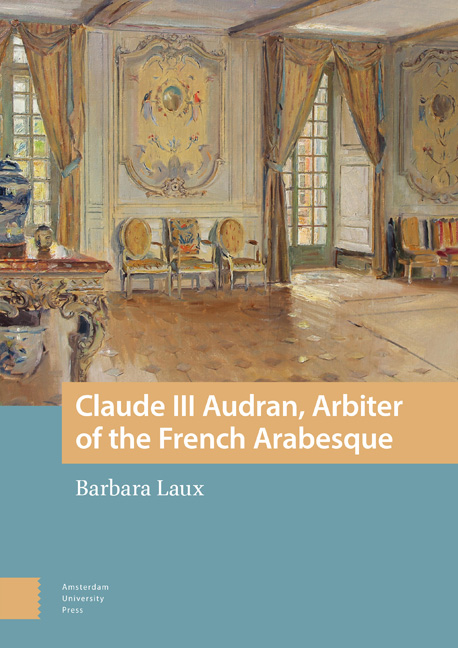Book contents
- Frontmatter
- Contents
- List of Illustrations
- Acknowledgements
- Introduction
- 1 Biography of Claude III Audran (1658–1734)
- 2 The French Arabesque as an Art Form, Audran as Master Ornamentalist , and His Initial Commissioned Works
- 3 Claude III Audran and Jean de La Fontaine’s Fables: Maintaining the Social Hierarchy
- 4 Attracting New Patrons in the Eighteenth Century
- 5 Claude III Audran’s Competitors and His Legacies
- Color Plates
- Appendix
- Bibliography
- Index
2 - The French Arabesque as an Art Form, Audran as Master Ornamentalist , and His Initial Commissioned Works
Published online by Cambridge University Press: 08 May 2024
- Frontmatter
- Contents
- List of Illustrations
- Acknowledgements
- Introduction
- 1 Biography of Claude III Audran (1658–1734)
- 2 The French Arabesque as an Art Form, Audran as Master Ornamentalist , and His Initial Commissioned Works
- 3 Claude III Audran and Jean de La Fontaine’s Fables: Maintaining the Social Hierarchy
- 4 Attracting New Patrons in the Eighteenth Century
- 5 Claude III Audran’s Competitors and His Legacies
- Color Plates
- Appendix
- Bibliography
- Index
Summary
Abstract
The chapter briefly reviews the origins of the arabesque from the sixteenth-century Italian grotesque to its introduction in France. Italian artists created influential designs for François I at the Château de Fontainebleau that inspired French artists. Charles Errard (1606–1689) and Charles Le Brun (1619–1690) established the precedent for Audran using the art form. Louis-Joseph de Bourbon, the duc de Vendôme (1654–1712), gave Audran his first significant commission at the Château d’Anet. Audran, assisted by François Desportes (1661–1743), ingeniously complemented the existing Renaissance motifs in the interiors with those of his own design. Subsequently, Audran worked for the Grand Dauphin (1661–1711) at the Château de Meudon and this project brought Audran's expertise to the attention of Louis XIV.
Keywords: Grotesque; Meudon; Château d’Anet; Les douze mois grotesques; Sceaux; Harpsichord
In the last decade of the seventeenth century, when Claude III Audran had completed his training and sought to establish himself professionally, he chose the arabesque as his mode of ornamental expression. This choice may have been suggested by his mentor or derived from other influences, but the definitive reason for his selection remains unknown. Audran joined a long tradition advanced by French artists, namely the use of decorative motifs that originated from the ancient Roman grotesque. He became especially well known for the facility with which he revitalized the ornamental vocabulary by introducing into it elements from popular culture. To elucidate Audran's achievement, this chapter begins with a brief history of the grotesque when it reached France. Use of the decorative motif spread through trade, such as decorative metalwork or the print media. A seminal moment occurred when François I enticed artists from Italy to come and work at Fontainebleau.
The original term “grotesque” was applied to the painted decorations that covered the walls and ceilings of the Domus Aurea or “Golden House” (64–68 CE), a large villa built in ancient Rome for Emperor Nero (r. 54–68 CE). After the emperor's death, the house was filled in with earth, and, when excavated some 1,400 years later, in the late fifteenth century, its rooms were mistaken for underground chambers or grottoes.
- Type
- Chapter
- Information
- Claude III Audran, Arbiter of the French Arabesque , pp. 69 - 100Publisher: Amsterdam University PressPrint publication year: 2024

